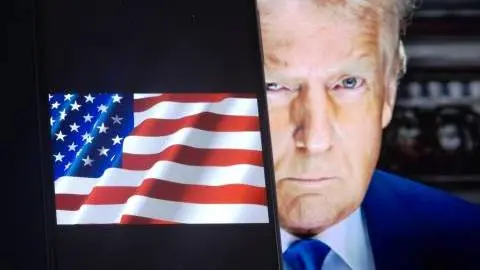How the European Union could counter US tariffs
With Trump ordering a 25% import tax on all steel and aluminium entering the US, trade tensions are inching closer to Europe. We take a closer look at how European policymakers could react. Spoiler alert: it's complicated
The Trump hurricane continues. Anyone still second-guessing the US president’s determination to implement his election promises into actual policy has been proven wrong. Up to now, the new US administration has closely followed the playbook of ‘Project 2025’.
Tariffs only play a minor role in ‘Project 2025' but have become the main lever in Donald Trump’s foreign policy agenda. From the on-and-off tariffs for Mexico and Canada, to the latest announcement of general import tariffs on steel and aluminium, tariffs are dominating headlines.
With the latest announcement, Europe is directly affected by the US administration’s decision. US tariffs on steel and aluminium of 25% will harm Europe’s manufacturers, which export some €3bn of steel and some €2bn of aluminium, thus affecting approximately 1% of total goods exports with the US. But this is not where it will stop. The looming threat of blanket tariffs on the EU and the announced trade reciprocity makes the question of how the EU could and will react more pressing.
Admittedly, we still don’t know what potential US tariffs on European goods will look like. Could it be a blanket tariff, or rather sectoral tariffs like the recently announced tariffs on steel and aluminium? From a US perspective, sector-specific tariffs could be more effective if the goal is to weaken international competitors of American producers and create divisions among European nations. However, if the primary aim is to generate revenue for tax-cut initiatives, a blanket tariff might be more appealing.
Options for Europe
Last autumn, we heard about a secret list circulating in Brussels detailing potential European responses if Donald Trump were to win the US elections and reintroduce tariff threats. This list has remained one of Brussels' best-kept secrets, as no details have been leaked thus far. Before we get to what could be on the list, let’s consider one typical European issue: how to react swiftly in times of crisis.
The good thing is that foreign trade falls under the sole responsibility of the European Commission, which makes laws on trade matters and negotiates and concludes international trade agreements. However, the EU lacks a trade instrument that would allow it to credibly threaten with immediate retaliation in case of a non-coercive breach of World Trade Organization (WTO) obligations by the US. Even with this secret list, the EU might not be able to react swiftly.
Yes, at the end of 2023, the EU put a trade bazooka in place, the so-called EU Anti-Coercion Instrument (ACI). It could be invoked if Trump attempts to impose duties on a specific member state, provided it gets the green light from a “qualified majority” of 15 out of the 27 member states, representing at least 65% of the bloc’s population. However, any reaction under the ACI would take some eight weeks, and it can't be triggered if Trump’s tariffs are not punitive or their adoption is made conditional on policy changes performed by the EU and its member states. The EU’s first problem, then, is speed.
Retaliation
If the EU reaches the stage where it can implement retaliatory tariffs, what might be included on the list?
- Impose tariffs on products primarily produced in US swing states, such as soybeans, bourbon, motorcycles or orange juice. In June 2018, the EU responded to US Section 232 tariffs on steel and aluminium with immediate retaliatory countermeasures in the range of 10-25%. Additional countermeasures were to be imposed after three years if no settlement was reached. After a deal had been struck under former President Joe Biden, those tariffs have been put on hold until 31 March 2025, meaning that the European Union could simply reinstate those retaliatory tariffs on US exports, with little delay.
- Europe could impose export tariffs on goods that are of strategic importance to the US. In 2022, the US relied on the EU for 32 strategically important import products, mainly in the chemical and pharmaceutical sectors. The EU could use this as a form of leverage in trade negotiations but should be aware of the US doing the same, potentially curbing chemical exports to Europe.
- The ultimate retaliation would be a digital services tax. While the EU enjoyed a substantial trade surplus in goods with the United States, amounting to €156bn in 2023, this was mostly offset by a significant trade deficit in services, which reached €104bn in the same year. Among those service exports are IT services, led by dominant American tech companies, charges for intellectual property or financial services. Notably, the United States holds the position of the world's largest exporter of services.
The art of making a deal
A long-held belief in Europe is that Trump is only after a good deal. We are a bit more sceptical. The Trump administration not only needs additional revenue to support its tax cut plans, but it may also have an interest in undermining an economic competitor.
Looking at the idea of making a deal, during Trump’s first presidency, the famous promise by former European Commission President Jean-Claude Juncker to buy more LNG and soybeans from the US prevented tariffs on European automotives. In the end, however, although the EU’s import of LNG and soybeans increased substantially – in the six months after the joint statement, LNG imports from the US increased by 181%, albeit from a low base, and soybean imports by 112%, making the US the largest supplier of soybeans to the EU – it didn’t really move the needle in terms of the overall goods trade surplus with the US. Instead, the trade surplus continued to widen. It would be naive for Europe to assume that Trump could as easily be appeased with a few soybeans as he was in 2018.
So, this time around, what does the EU have to offer Trump to strike a deal and avoid a trade war?
- The first thing that comes to mind is more LNG purchases. However, the US is already the largest LNG supplier to the EU, with 40% of the EU’s LNG imports coming from the US in the third quarter of 2024. How much more room is there to increase these imports?
- Another option could be to not only increase the EU’s defence spending to 3% or 4% of GDP but also commit to increased purchases of US military products. Currently, the EU imports 55% of its military products from the US already (for the period 2019-23), a substantial increase from 35% between 2014-18, according to SIPRI. The EU could also offer to reduce import tariffs on US automotives. While tariffs on imported cars are 2.5% in the US, tariffs stand at 10% in the EU. Thus, to achieve a level playing field, the EU could offer to lower its tariffs on US cars to 2.5%. Yet, to stay compliant with the WTO’s Most Favoured Nation (MFN) concept, it would have to extend this tariff reduction to all WTO members.
- In all of these cases, it is important to note that the European Commission holds the sole responsibility for trade policy negotiations but cannot force member states to purchase goods from specific suppliers. Yes, the EU has successfully used joint procurement for Covid-19 vaccines, gas supplies, and ammunition for Ukraine but it takes time to set up these joint procurements. Additionally, since participation is voluntary, some purchases may still fall through.
Back to Draghi
As much as Europe will try to prepare for an upcoming possible trade war with the US, let’s not forget that trade wars will not be won by the trade surplus country. It is always the surplus countries that have more to lose. Therefore, Europe might want to consider another route: the strengthening of the domestic economy. Think of reducing dependency on the US by increasing domestic military industries, including reducing too many technological standards of weapons systems and pooling of defence purchases, and deregulation of the tech sector, including significant investments. The latest AI initiative by the French government points in that direction.
Beyond these efforts to reduce US dependencies, Europe should focus on implementing as many proposals from the Draghi report as possible.
Europe is better prepared but speed and power remain a problem
Although the EU is better prepared to tackle Trump 2.0, it still faces a complex challenge in countering potential US tariffs. While the EU has several options at its disposal, including retaliatory tariffs on key US exports and the implementation of a digital services tax, the effectiveness of these measures will depend on the EU's ability to act swiftly and cohesively.
The EU Anti-Coercion Instrument (ACI) offers a framework for response, but its effectiveness is hampered by procedural delays and the requirement for widespread member state support.
This publication has been prepared by ING solely for information purposes irrespective of a particular user's means, financial situation or investment objectives. The information does not constitute investment recommendation, and nor is it investment, legal or tax advice or an offer or solicitation to purchase or sell any financial instrument. Read more
Download
Download article
12 February 2025
Our analysts’ views on Trump’s tariff developments this week This bundle contains 4 Articles
